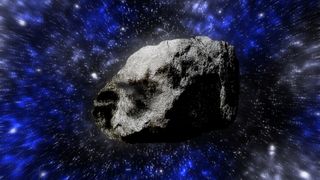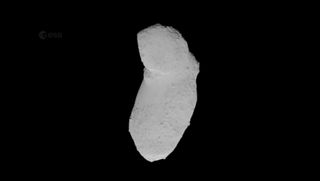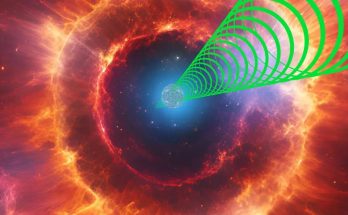When the ‘God of chaos’ asteroid Apophis makes an ultraclose flyby of Earth in 2029, our planet’s gravity may trigger tremors and landslides that totally change the asteroid’s surface.

An illustration of a massive asteroid headed toward Earth. The “God of chaos” asteroid Apophis will come exceptionally close to Earth in 2029. (Image credit: JuanCi via Getty Images)
Named after Apep, the ancient Egyptian god of chaos, Apophis is a 1,100-foot-long (340 meters), peanut-shaped asteroid. Although an impact with a space rock that size wouldn’t annihilate our planet, it could easily destroy a city.
Given that distance, Apophis probably won’t affect Earth much in 2029. But how will the asteroid itself fare after this close encounter?
That question intrigued Ronald-Louis Ballouz, an asteroid scientist at the Johns Hopkins University Applied Physics Laboratory. Tiny meteoroids constantly bombard asteroid surfaces in a process called space weathering, Ballouz told Live Science in an email. However, Ballouz added that astronomers have long seen that asteroids that pass close to planets like Earth often lack weathered surfaces.
The exact physical mechanism that removes the evidence of weathering isn’t well known, Ballouz said. One possibility is that a planet’s gravity pulls on rocks on an asteroid’s surface, tossing them away and revealing the underlying layer.
To test this hypothesis, Ballouz and a group of international researchers created computational models of Apophis. Few of the asteroid’s physical features are known, so the researchers based their models on a similar two-lobed asteroid, Itokawa, which has been studied in greater detail. The researchers then simulated each model’s movement toward Earth, tracking both large- and small-scale physical changes.

The researchers discovered that two physical processes — triggered by Earth’s gravitational tugs — will likely sculpt Apophis’ surface during its 2029 encounter. One is tremors that will probably begin an hour before Apophis reaches its closest point to Earth and continue for a short while after.
The tremors’ strength is difficult to estimate, Ballouz said. However, “Apophis’ gravity is about 250,000 times smaller than Earth’s,” he added. “So, we think that events of much smaller magnitude could plausibly shake things up on its surface.”
This means the quakes may be intense enough to loft boulders from Apophis’ surface. While some rocks may escape, most will fall back onto Apophis, creating distinct surface patterns that a passing spacecraft could identify.
The other process that could “refresh” Apophis’ surface is a change in its tumbling. Tumbling occurs because the asteroid doesn’t rotate on a fixed axis or time period; instead, it tumbles through space like a badly thrown football.
An unrelated 2023 study showed that Earth’s gravity would cause the asteroid to rotate either more quickly or more slowly depending on its orientation during the 2029 approach. The new simulations confirmed this finding. They also revealed that the changes in Apophis’ tumbling will cause the sloping faces of surface rocks to destabilize, potentially triggering landslides in extreme cases. Unlike the seismic shaking, these changes will occur gradually, over tens of thousands of years.
Ballouz and his colleagues hope that NASA’s OSIRIS-APEX mission will confirm their hypotheses. Repurposed from OSIRIS-REx — the spacecraft that picked up samples from the asteroid Bennu — OSIRIS-APEX is scheduled to study Apophis during its 2029 encounter. It will rendezvous with the asteroid for 18 months to study its chemical composition and chart its surface.
The study, currently available on the arXiv preprint database, has been accepted for publication in The Planetary Science Journal.


